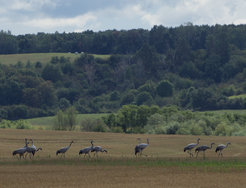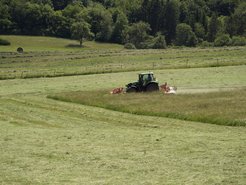Not just a pretty place: grassland plant diversity benefits wildlife, agriculture, and tourism
This press release was kindly provided by the Senckenberg Gesellschaft für Naturforschung.
In a long-term study, an international team led by Senckenberg researchers Dr. Gaëtane Le Provost and Dr. Peter Manning, including Dr. Marion Schrumpf and Dr. Ingo Schöning from MPI-BGC, has demonstrated the importance of grassland biodiversity for a wide range of ecosystem services and various stakeholder groups. The study now published in the journal “Nature Ecology & Evolution,” is the first to expand the view to a total of 16 ecosystem services – from ecological to cultural – and to examine the biodiversity of agricultural meadows and pastures on a large scale. The researchers show that a high plant diversity benefits local actors – across sectors from tourism to agriculture.
Species-rich meadows provide habitat for bees and other insects that provide ecosystem services such as pollination and natural pest control. But what about less obvious ecosystem services provided by organisms in the soil? And exactly how does a high biodiversity affect people’s experience of nature, which benefits local tourism as by providing a leisure activity and recreational opportunity?

To gain a comprehensive picture of these biodiversity dynamics, an international research team led by Dr. Gaëtane Le Provost and Dr. Peter Manning from the Senckenberg Biodiversity and Climate Research Center in Frankfurt studied agricultural meadows and pastures in various rural regions in Germany. In the process, they evaluated data that were collected continuously since 2006 as part of the “Biodiversity Exploratories” project. This takes place in the areas of the Swabian Alps of Southern Germany, the Hainich-Dün region of central Germany, and the Schorfheide-Chorin Biosphere Reserve north of Berlin.

“The areas differ in climate and topography while also serving as examples of the different types of typical grassland use in Central Europe,” explains Le Provost. She continues, “We studied 150 grassland areas between 2006 and 2018, and for the first time examined 16 different ecosystem services – ranging from forage quality and numerous soil quality factors such as carbon storage or groundwater recharge, to so called cultural ecosystem services related to our experience of nature. For example, the opportunity for birdwatching, the therapeutic sight of a lush meadow in bloom, and the wealth of acoustic stimuli provided by a species-rich grassland through birdsong and other nature sounds. We were able to demonstrate that high plant diversity has a positive effect on a very large number of these ecosystem services!

For the first time, the researchers also examined the significance of ecosystem services for various local stakeholders in their study, which was has just been published in the journal “Nature Ecology & Evolution.” In cooperation with the ISOE – Institute for Social Ecological Research local residents as well as representatives of nature conservation organizations and the agricultural and tourism industries, among others, were invited to attend workshops and surveyed for their views. “We found that, without exception, all of the groups surveyed benefited from a high level of biodiversity – from local residents to the tourism industry,” reports Sophie Peter, a research associate at the ISOE.
Finally, the research team was able to demonstrate the benefits of high plant diversity, not only in small plots of ground, but also across the wider agricultural environment. “The fact that the plant diversity of the surrounding area influences the provision of various ecosystem services over these wider areas is important for local decision-makers,” emphasizes Manning, who adds in summary, “Political decisions on land use are usually made on a large geographic scale. Our data show that even at these large scales, a high plant diversity offers benefits to entire rural communities!”














